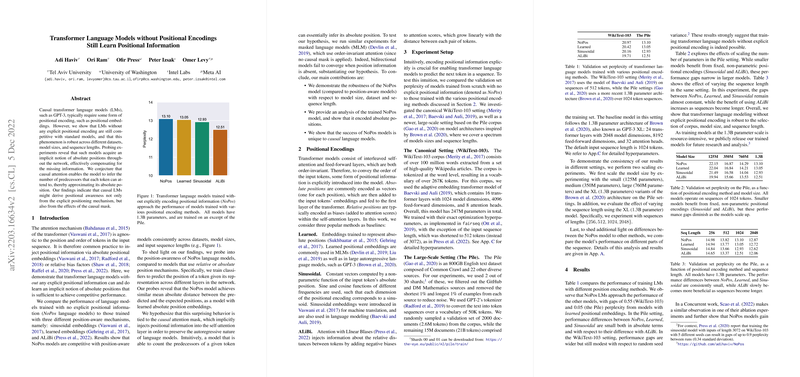Exploring Transformer LLMs' Implicit Positional Learning Capabilities
Introduction to NoPos LLMs
Recent research has unveiled that causal transformer LLMs (LMs), traditionally hinged on positional encodings for discerning the order of input tokens, demonstrate remarkable resilience and competitive performance even in their absence. In a thorough examination encompassing various datasets, model sizes, and sequence lengths, these so-called No Positional Encoding (NoPos) models not only hold their ground against traditionally engineered LMs but also reveal an intrinsic capability to grasp absolute positional information.
Methodology
The paper compares NoPos models against those equipped with conventional positional encoding mechanisms—including sinusoidal, learned embeddings, and Attention with Linear Biases (ALiBi)—across benchmarks like WikiText-103 and the Pile. Surprisingly, the NoPos models exhibit minimal performance gaps when juxtaposed with models leveraging explicit positional cues, hinting at the innate adaptation prowess of the transformer architecture in handling sequential data.
In-depth Analysis
To dissect the underpinnings of positional awareness in NoPos models, the paper employs probing classifiers tasked with predicting token positions based on their representations at different network depths. The findings are compelling; NoPos models attain positional prediction accuracy almost on par with that of their positionally informed counterparts. This observation stems from transformers' causal attention mechanism, which imparts an implicit understanding of sequence order by restricting each token's scope of attention to its predecessors. However, this inherent positional inference mechanism seemingly falters in models lacking a directional attention constraint, such as bidirectional models employed in tasks like masked LLMing (MLM).
Scaling Effects and Sequence Length Dynamics
Further experimentation elucidates the impact of scaling model parameters and varying input sequence lengths. Smaller NoPos models showcased some performance lag behind their positionally encoded peers; however, this gap dwindles noticeably as model size increases. Moreover, the advantage of specific positional encoding techniques like ALiBi becomes more pronounced with an elongation of sequence lengths, underlining the nuanced interplay between model size, sequence length, and positional encoding efficacy.
NoPos Models' Positional Information Utilization
A pivotal part of the paper focuses on understanding how and why NoPos models leverage implicit positional information. By selectively shuffling token order in the input sequences and observing the subsequent effects on model perplexity, it becomes evident that NoPos models indeed rely on the acquired positional awareness for making accurate predictions, thereby debunking any notions of order invariance in LLMing.
Hypotheses and Future Directions
The paper posits that the autoregressive causal attention mechanism inherently equips NoPos transformer models with the ability to gauge the sequence position of tokens by recognizing the number of attendable predecessors. This insight opens intriguing avenues for further exploration, particularly in how transformers can be designed or trained to enhance this implicit positional learning capability. Moreover, the observed discrepancy in performance between NoPos causal LMs and their bidirectional MLM counterparts raises questions about the broader implications of implicit positional learning across different transformer applications.
Theoretical and Practical Implications
This paper sheds light on the fundamental capabilities of transformer architectures in implicitly learning positional information, challenging the prevalent assumption about the necessity of explicit positional encodings. The practical ramifications are profound, offering a fresh perspective on model design—potentially easing the computational and memory overhead associated with positional embeddings. On the theoretical front, these findings beckon a reevaluation of our understanding of sequence modeling and representation learning within neural networks.
Concluding Remarks
The investigation into NoPos transformer LLMs divulges their adeptness at implicitly learning sequence positions, thereby recalibrating our understanding of positional encoding's role within transformer architectures. As the field of AI research continues to grapple with the intricacies of LLMing, the nuances unearthed in this paper offer a promising trajectory for optimizing and rethinking model architectures moving forward.
